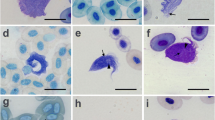Abstract
The taxonomic status of Trypanosoma rangeli as well as the tools for its molecular characterization is briefly commented.
Similar content being viewed by others
The Trypanosoma rangeli dilemma
Trypanosoma rangeli is a second parasite of this genus that infects humans as well as wild and domestic mammals in Central and South America. Reports from Panama to Southern Brazil have described innumerable mammalian species naturally infected by this parasite. Triatomine bugs, especially those of the Rhodnius genus, are vectors of T. rangeli among vertebrate hosts. Since human infections by T. rangeli have been described in several countries, the occurrence of single and/or mixed infections with T. cruzi must be considered in areas where these parasites are sympatric. During the last few years, biological, biochemical and molecular characterization of several T. rangeli isolates has revealed the genomic and antigenic plasticity of this parasite, for which the life cycle in the mammalian host is still unknown [1]. Few previous studies on the parasite life cycle carried out in laboratories that co-cultivate T. cruzi and T. rangeli have used poorly characterized strains, which lead to dubious results. Considering the taxonomic relationship, the inter and intraspecific variability of T. rangeli and T. cruzi and the fact that they share at least 60% of their soluble antigenic constitution, several techniques can present cross-reactivity leading to wrong or inconclusive results. Actually, T. rangeli strains can be classified into, at least, two major phylogenetic groups, which have a close relationship with geographical origin and local vector(s) [2]. Based on these similarities and differences, discussions concerning its taxonomic position have arisen. Since Hoare's seminal monograph [3], the terms Salivaria and Stercoraria have been widely discussed. Unlike T. cruzi, T. rangeli is mainly transmitted by bite as observed for a typical salivarian species, such as the African trypanosomes. However, the parasite shows biological characteristics that are not compatible with the description of the salivaria. Despite intensive discussions on the biological cycle and taxonomic position of T. rangeli, no common sense came phylogeny has so far been adopted. Considering the presence of T. rangeli in a wide geographical area in Latin America, we must look forward and focus on specific topics such as i) the parasite similarities and differences from T. cruzi, on both genomic and antigenic levels, ii) the life cycle within triatomine vectors, iii) its taxonomic position and iv) the unknown life cycle in mammalian hosts. In order to address these, and several other important points, better; we have to consider the revision of old parameters (such as Dr. Hoare's classification) using modern techniques to evaluate as many markers as possible. Among several valuable techniques used to differentiate T. rangeli from T. cruzi, as well as to characterize isolates or strains, we must consider the use of lectin binding, isoenzymes, RAPD, schizodeme profiles, sequence analysis of nuclear genes (spliced-leader, ITS, rRNA) and kDNA, triatomine susceptibility, immunofluorescence and ELISA using monoclonal antibodies or recombinant antigens. The usefulness of these techniques in diagnosis and characterization of T. rangeli strains has already been reported in the literature, revealing a high polymorphism among strains isolated from distinct reservoirs, vectors and geographical origins. Nevertheless, none of these recent and powerful techniques will be able to address these points if parasite strains are not well characterized by biological and molecular methods before and after experimental studies in order to avoid cross-contamination [4]. Nowadays, our group is using GFP-transfected T. rangeli strains to study the parasite life cycle in both vertebrate hosts and vectors.
References
Grisard EC, et al: Characterization of Trypanosoma rangeli strains isolated in Central and South America: An overview. Mem. Inst. Oswaldo Cruz. 1999, 94: 203-209.
Vallejo GA, et al: KDNA markers define two major Trypanosoma rangeli lineages in Latin-America. Acta Tropica. 2002, 81: 77-82. 10.1016/S0001-706X(01)00186-3.
Hoare C: Herpetosoma from man and other mammals. In: The trypanosomes of mammals: A zoological monograph. Blackwell Scientific. 1972, 288-323.
D'Alessandro A, Saravia NG: Trypanosoma rangeli. In: Protozoal Diseases. Edited by: Gilles HM. 1999, Arnold Press, 398-412.
Author information
Authors and Affiliations
Corresponding author
Rights and permissions
This article is published under an open access license. Please check the 'Copyright Information' section either on this page or in the PDF for details of this license and what re-use is permitted. If your intended use exceeds what is permitted by the license or if you are unable to locate the licence and re-use information, please contact the Rights and Permissions team.
About this article
Cite this article
Grisard, E.C. Salivaria or Stercoraria? The Trypanosoma rangelidilemma. Kinetoplastid Biol Dis 1, 5 (2002). https://doi.org/10.1186/1475-9292-1-5
Received:
Accepted:
Published:
DOI: https://doi.org/10.1186/1475-9292-1-5




